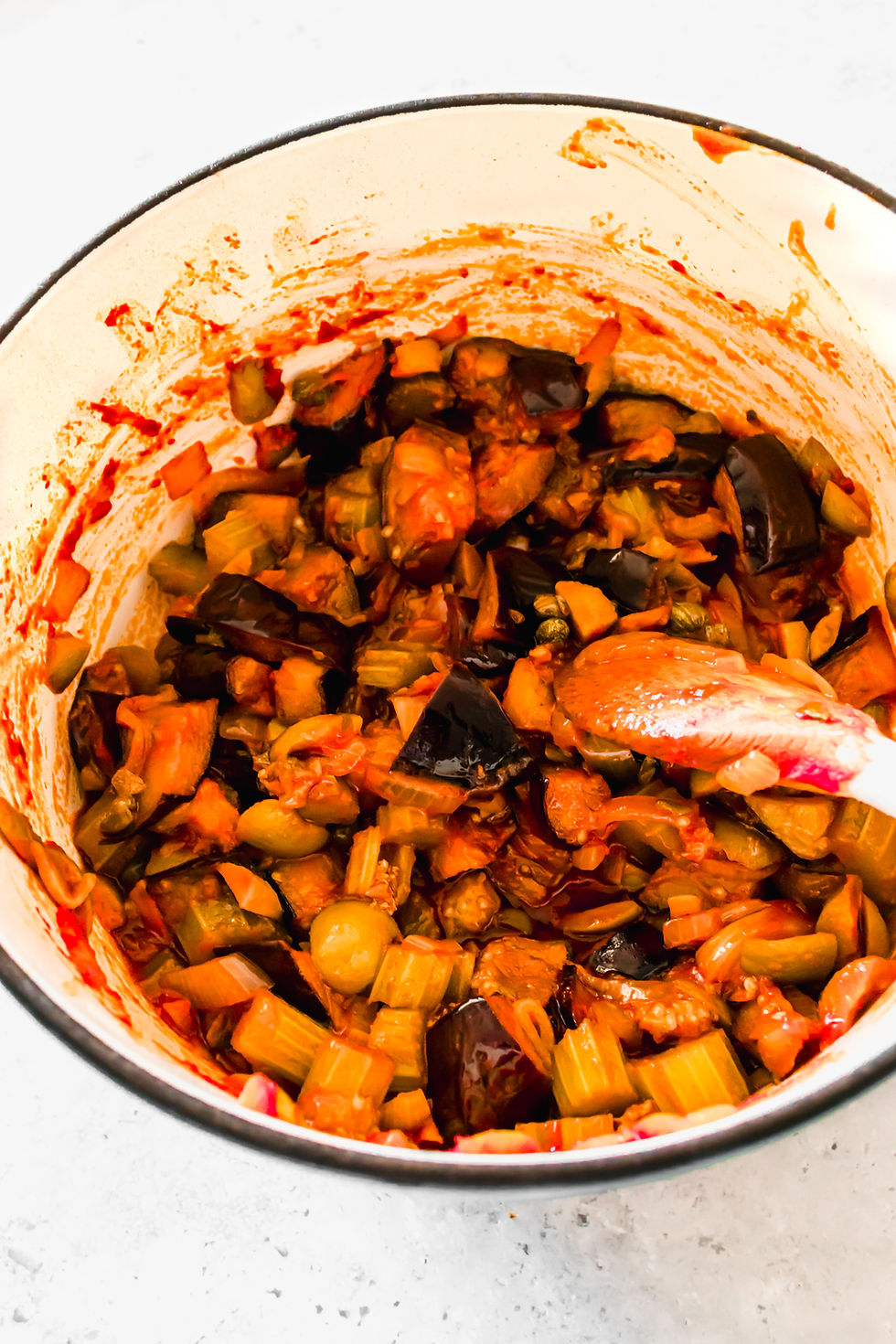Aubergine Caponata
- valeriapinasco96
- 1 day ago
- 3 min read
Sweet, sour and utterly delicious - this Sicilian dish is a classic for a reason. Traditionally served cold, it is the perfect side dish or starter for Sunday lunch.

I recently spent a week in Sicily and it has reminded me of why it is one of my favourite regions. Its people are warm and welcoming. Its architecture is beyond incredible. And then there is the food, which is some of the best I have ever had.
I was lucky to be introduced to Sicilian food very early on in my life, as a dear family friend of ours comes from Palermo, and would often have us over for Sunday lunch, where she'd cook us a veritable spread of traditional Sicilian food. From aubergine parmigiana to sfincione and pasta ca' muddica, I was always so amazed by the flavours of her food, so different from the Ligurian cooking I had always known. It was at one of her Sunday lunches that I was first introduced to aubergine caponata, a sweet and sour aubergine (or eggplant) side dish or starter, traditionally eaten cold, which simply bursts with flavour. It was unlike any vegetarian dish I had ever tasted. Since then, caponata has become one of my favourite foods to have when I am in Sicily, and I surely had plenty of it on my recent trip. So, when I spoke to said family friend and explained to her that I wanted to do a recipe series on the blog, exploring regional food, she kindly shared her own family recipe for aubergine caponata, and I am ever so grateful she did.

A few things to note when making caponata
You'll need time: this can be said for most Sicilian cooking, but caponata is deceptively time consuming. You need to go through a few steps and then there is quite a bit of simmer time. That's why a lot of traditional Sicilian food is made over the weekend, and I definitely think it's a worthy cooking project for your next Sunday at home.
This is Palermo's version: caponata is done differently is different areas of Sicily. Some areas add peppers, for example. But the one from Palermo has only one 'main' vegetable, and that is aubergine.
It's best eaten the following day: leaving the caponata to sit overnight in the fridge is the best way to enjoy it - the flavours really develop and it ensures you eat it super cold, as tradition dictates (but if you want to warm it up, or add it to pasta I will not judge you - a Sicilian might though!).

Ingredients (serves 4)
1 large brown onion
3 celery sticks
2 aubergines
2 tbsp capers
15 large pitted green olives
3 tbsp tomato puree
125ml white wine vinegar
1 tbsp sugar
Olive oil
Method:
Dice the aubergines into 3cm chunks. Add them to a large bowl and cover with water and 1 tsp salt. Set aside
Cut the celery into 2-3cm half-moons. Add them to a saucepan of boiling water and boil for 2-3 mins, until just tender. Drain and set aside.
Drain the aubergines and pat dry with a clean tea towel. Heat a large frying pan with enough olive oil to cover the surface of the pan (about 75ml) on high heat. Once hot, add the aubergine chunks (in batches if needed, as it's best not to overcrowd the pan). Reduce the head to medium-high and shallow fry the aubergines, turning them frequently, until softened and golden brown all over. Transfer to a plate lined with paper towel.
Halve the olives. Thinly slice the onion. Heat a dutch oven or large pot with 2 tbsp olive oil, then add the onion. Cook for 4-5 mins, until softened. Add the celery, capers, olives and tomato puree and continue cooking for another 2-3 mins.
Meanwhile, mix the vinegar and sugar until combined. Add the fried aubergines to the pot, cover with a lid, lower the heat and simmer for 3-4 mins. Add the vinegar mix to the pot, stir to combine and cook uncovered for another 1-2 mins.
Taste the caponata and add more salt, vinegar or sugar as needed - just bear in mind that the vinegar flavour will come out slightly stronger after the caponata has rested in the fridge overnight.
Let your caponata cool down, then transfer to the fridge. Although caponata can be eaten warm and immediately, it's best to leave it in the fridge for a minimum of six hours, or as mentioned, preferabily overnight, and served cold.




Comments